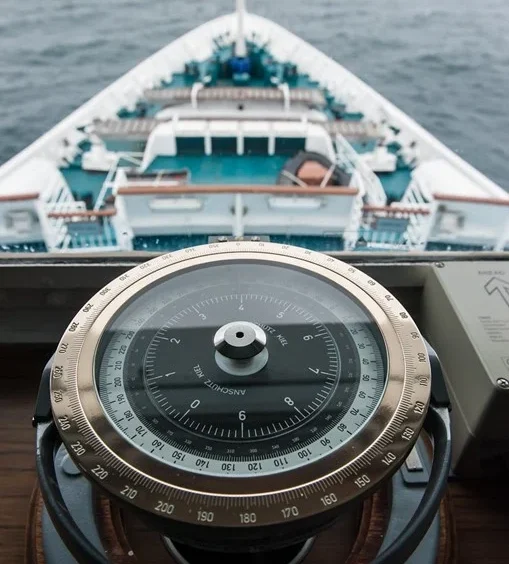Gyro Compass: The Unseen Navigator of the Seas
Ever stopped to think how a ship manages to stay on course, even when it’s pitch dark, the radar’s cluttered, and magnetic signals are going haywire? That’s where the gyro compass quietly does its thing. No spotlight, no drama — just solid, steady navigation.
Most folks don’t even know it’s there. But without it? Modern ships would be guessing. It’s not like your regular compass either — this one doesn’t care about magnets or interference. It finds true north and just sticks with it — no second-guessing, no drifting.
The old-school magnetic compass? It can be thrown off by nearby equipment or even a passing storm. But the gyro compass doesn’t flinch. It stays steady, no matter what’s going on around it.
How? It’s all thanks to a spinning core and the Earth’s own movement. Sounds complex, but the idea is simple — once it locks on, it doesn’t let go.. Sounds fancy, but basically, it finds north and sticks with it — even in rough seas or tricky conditions.
It’s not loud, flashy, or famous. But without it, a lot of ships would literally lose their way
What is a Gyro Compass?
A gyro compass is a navigational instrument that points to true north, not at all like the magnetic compass which depends on the Earth’s magnetic field. This makes it incredibly solid, particularly for ships working in high-latitude regions or regions with overwhelming magnetic interference.
Unlike a magnetic compass, the gyro compass is not tricked by steel hulls, nearby cargo, or changes in magnetic variation. Instead, it works on the principles of gyroscopic inertia and Earth’s rotation, giving a more exact, steady, and reliable heading.
At the core of the gyro compass is a fast-spinning rotor, suspended in a way that lets it move freely — kind of like it’s floating on a set of rings. Once it’s spinning, it doesn’t like to change direction, thanks to something called angular momentum.
As the Earth rotates, and with a little help from gravity, the system slowly shifts and lines itself up with true north — not magnetic north, but the real deal. No magic, just clever physics doing the heavy lifting.
To keep the rotor in the horizontal plane and guide it toward true north, frameworks like gravity control and damping are utilized. The result? A heading indicator that doesn’t sway with magnetic deviation or distort with ship movement.
Why Gyro is the true MVP of Navigation
Points to True North: Magnetic compasses can drift, but the gyro compass stays focused.
Immunity to Magnetic Interference: Steel ships, electronic equipment, or cargo won’t affect its accuracy.
System Integration
The gyro compass doesn’t just sit there pointing north — it shares that heading data with other key systems on the ship. We’re talking autopilot, ECDIS, AIS, radar — basically everything that needs to know which way the vessel is heading.
Improved Stability
Even when the sea’s throwing a fit, the gyro compass holds steady. That means smoother, more reliable navigation info, especially when things get rough.
Common Errors in Gyro Compasses:
Gyro Drift
Over time, even the best gyro can drift a little off course. Nothing dramatic — but it does need regular checks to keep it sharp.
Latitude & Speed Errors
Because it relies on Earth’s rotation, the system needs to adjust for your position and how fast you’re moving. If that’s off, so is your heading.
Power Dependency
No power? No compass. It’s fully electric, so a blackout can leave it blind unless there’s a backup.
Initial Alignment
If the setup isn’t done right in the beginning, everything that follows can be off. First impressions matter — even for a compass.
Routine Checks & Maintenance
- A simple but solid practice now and then, compare your heading with a celestial bearing or the magnetic compass. Just to make sure the gyro’s still on point.
- Monitor for drift and perform reset if necessary.
- Ensure smooth synchronization with ECDIS and autopilot.
- Inspect the power supply and backup systems.
- Follow SOLAS maintenance intervals.
Regulations Backing It Up : As per SOLAS Chapter V, Regulation 19, all passenger ships and cargo ships over 500 GT on worldwide voyages must carry a gyro compass or equivalent framework. It must also transmit heading information to radar, AIS, and other critical navigation tools. Regular inspections are mandated by flag states and classification societies to guarantee full operational status before port state control checks.
Where to Spot Your Gyro Onboard – It’s Everywhere!
The gyro compass isn’t just one box in a room. It’s a full framework with different repeaters set in key locations:
Gyro Master Unit: Often in the gyro room, close to the bridge, disconnected from heat and vibration.
Bridge Console: For the helmsman’s direct reference.
Radar Display: Ensures true bearing presentation.
Navigation Table: Utilized amid passage planning.
Autopilot Panel: Gives live heading input.
Engine Control Room and Aft Steering: For emergency redundancy and monitoring.
This network guarantees consistent accessibility of heading information all through the vessel.
Conclusion: Believe in the True North The gyro compass has revolutionized navigation. Its capacity to deliver true north alignment, overlook magnetic influences, and coordinated with bridge frameworks makes it crucial. For today’s mariners, it is more than a compass—it is a noiseless accomplice guaranteeing accuracy and security on each voyage.
Whether steering through a storm or entering a busy port, a well-maintained gyro compass keeps your course true and your certainty tall.


